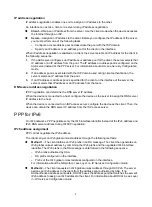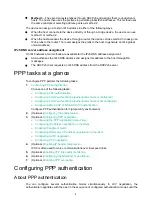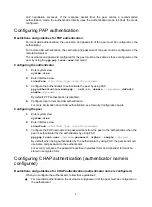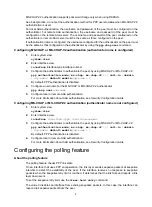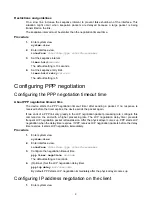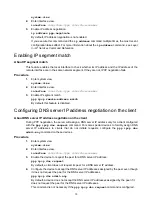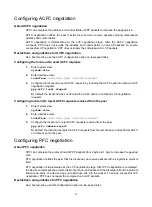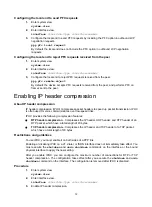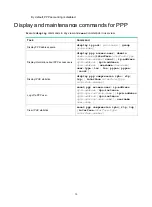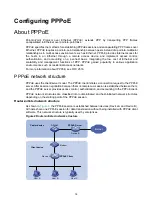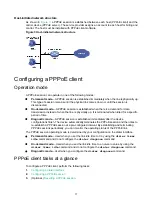
3
IP address negotiation
IP address negotiation enables one end to assign an IP address to the other.
An interface can act as a client or a server during IP address negotiation:
•
Client
—Obtains an IP address from the server. Use the client mode when the device accesses
the Internet through an ISP.
•
Server
—Assigns an IP address to the client. Before you configure the IP address of the server,
you must perform one of the following tasks:
{
Configure a local address pool and associate the pool with the ISP domain.
{
Specify an IP address or an address pool for the client on the interface.
When IP address negotiation is enabled on a client, the server selects an IP address for the client in
the following sequence:
1.
If the AAA server configures an IP address or address pool for the client, the server selects that
IP address or an IP address from the pool. The IP address or address pool is configured on the
AAA server instead of the PPP server. For information about AAA, see
Security Configuration
Guide
.
2.
If an address pool is associated with the ISP domain used during client authentication, the
server selects an IP address from the pool.
3.
If an IP address or address pool is specified for the client on the interface of the server, the
server selects that IP address or an IP address from that pool.
DNS server address negotiation
IPCP negotiation can determine the DNS server IP address.
When the device is connected to a host, configure the device as the server to assign the DNS server
IP address to the host.
When the device is connected to an ISP access server, configure the device as the client. Then, the
device can obtain the DNS server IP address from the ISP access server.
PPP for IPv6
On IPv6 networks, PPP negotiates only the IPv6 interface identifier instead of the IPv6 address and
IPv6 DNS server address during IPv6CP negotiation.
IPv6 address assignment
PPP cannot negotiate the IPv6 address.
The client can get an IPv6 global unicast address through the following methods:
•
Method
1
—The client obtains an IPv6 prefix in an RA message. The client then generates an
IPv6 global unicast address by combining the IPv6 prefix and the negotiated IPv6 interface
identifier. The IPv6 prefix in the RA message is determined in the following sequence:
{
IPv6 prefix authorized by AAA.
{
RA prefix configured on the interface.
{
Prefix of the IPv6 global unicast address configured on the interface.
For information about the ND protocol, see
Layer 3—IP Services Configuration Guide
.
•
Method
2
—The client requests an IPv6 global unicast address through DHCPv6. The server
assigns an IPv6 address to the client from the address pool authorized by AAA. If no
AAA-authorized address pool exists, DHCPv6 uses the address pool that matches the server's
IPv6 address to assign an IPv6 address to the client. For information about DHCPv6, see
Layer
3—IP Services Configuration Guide
.















